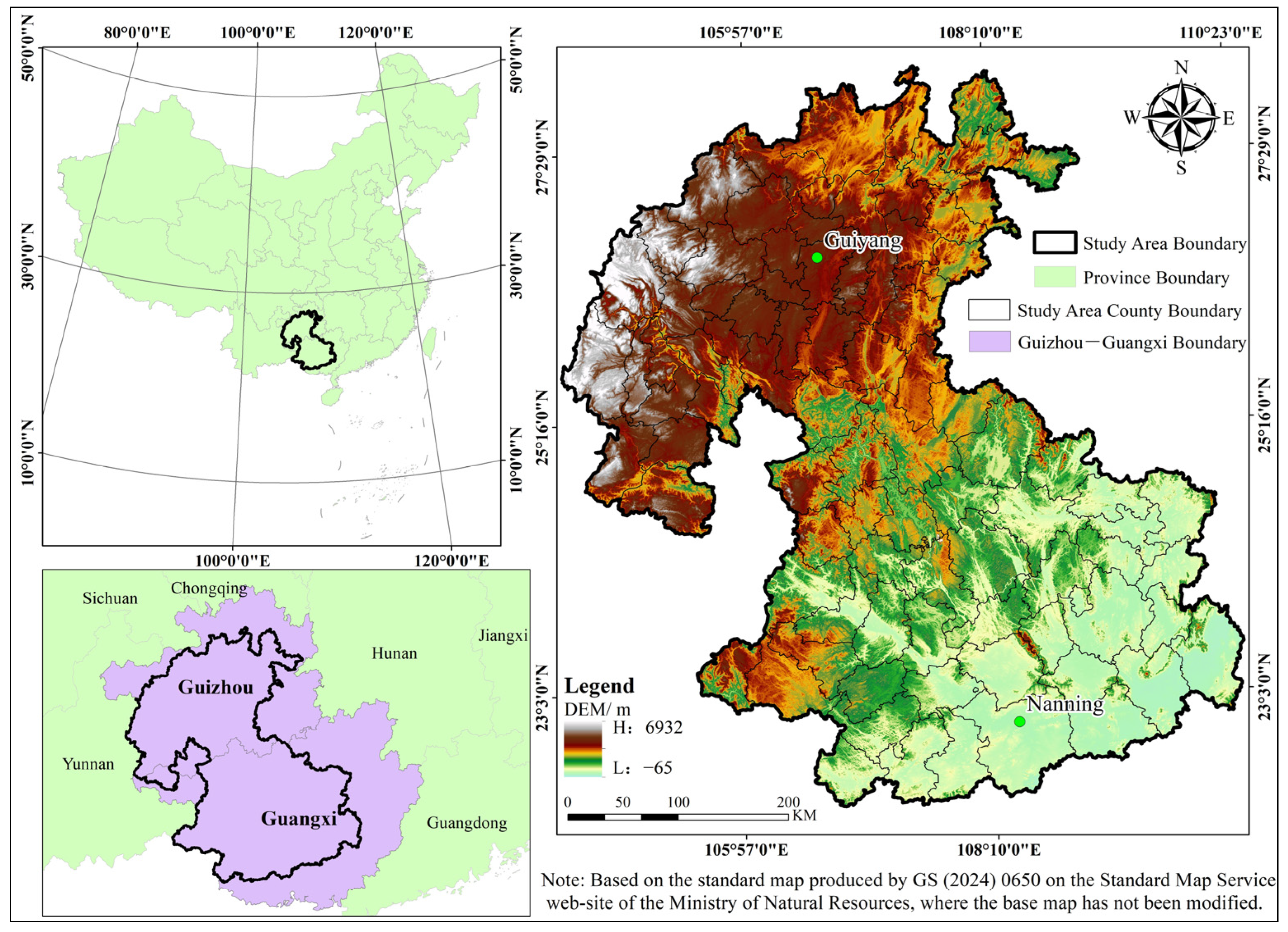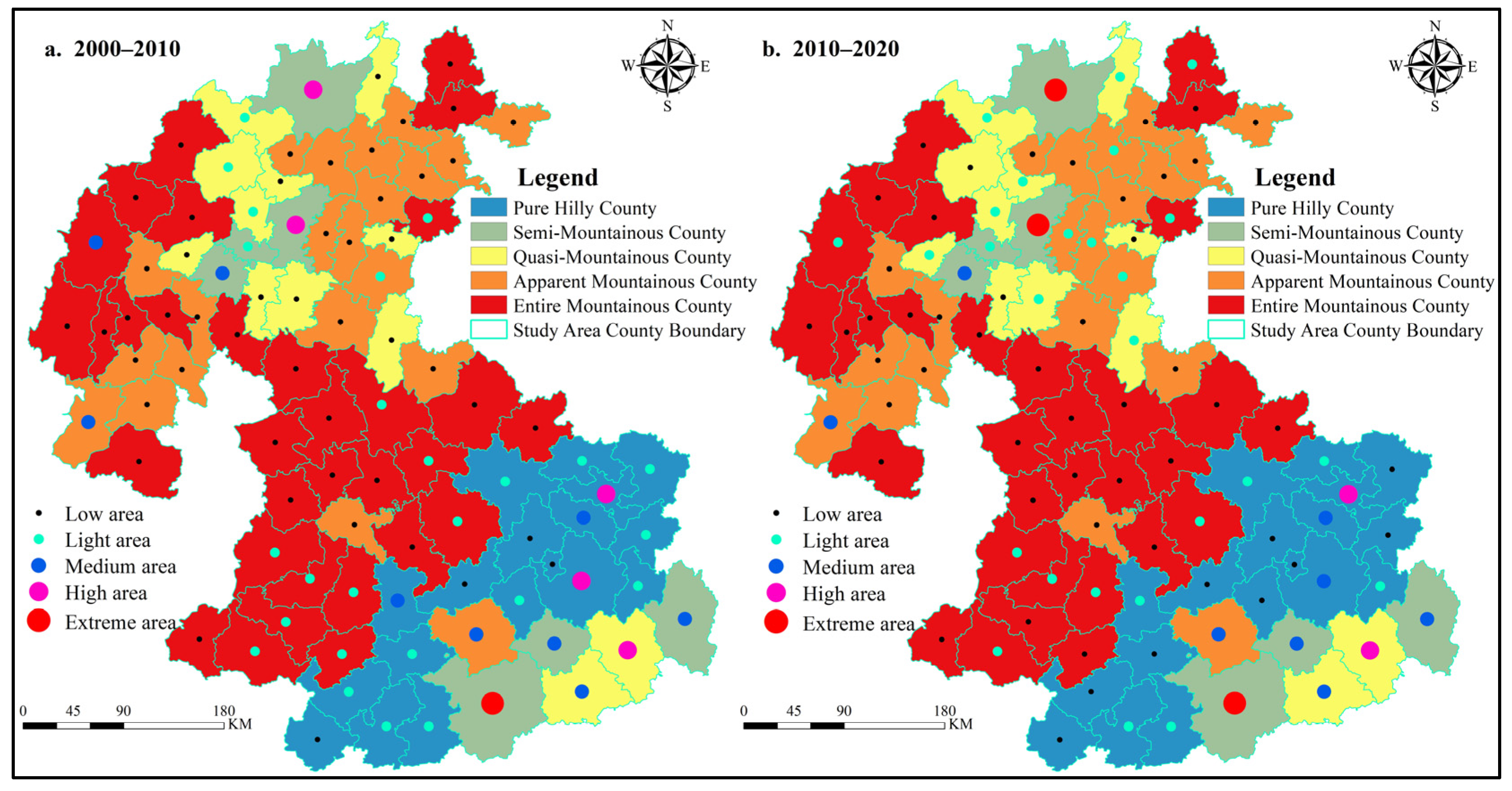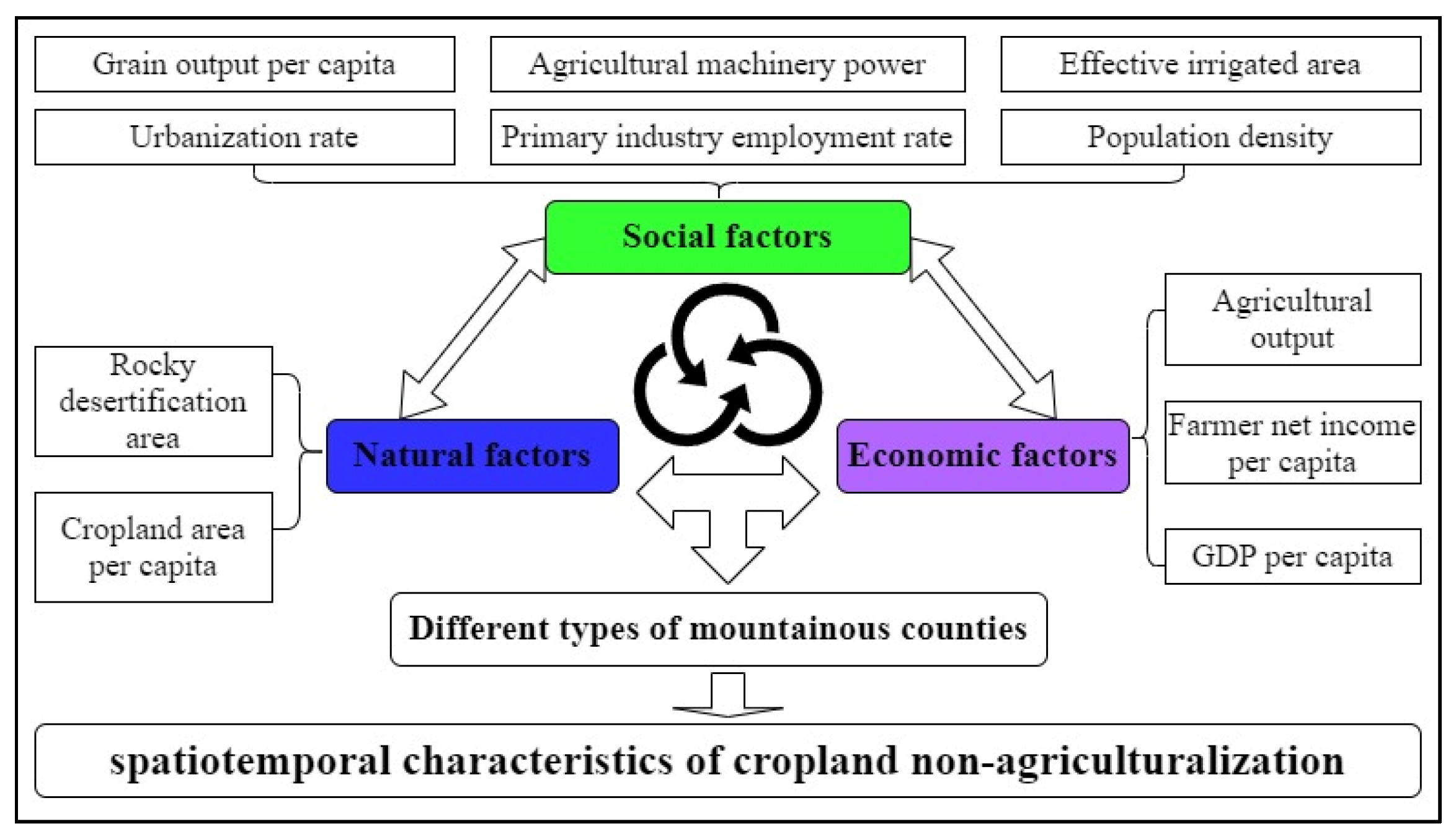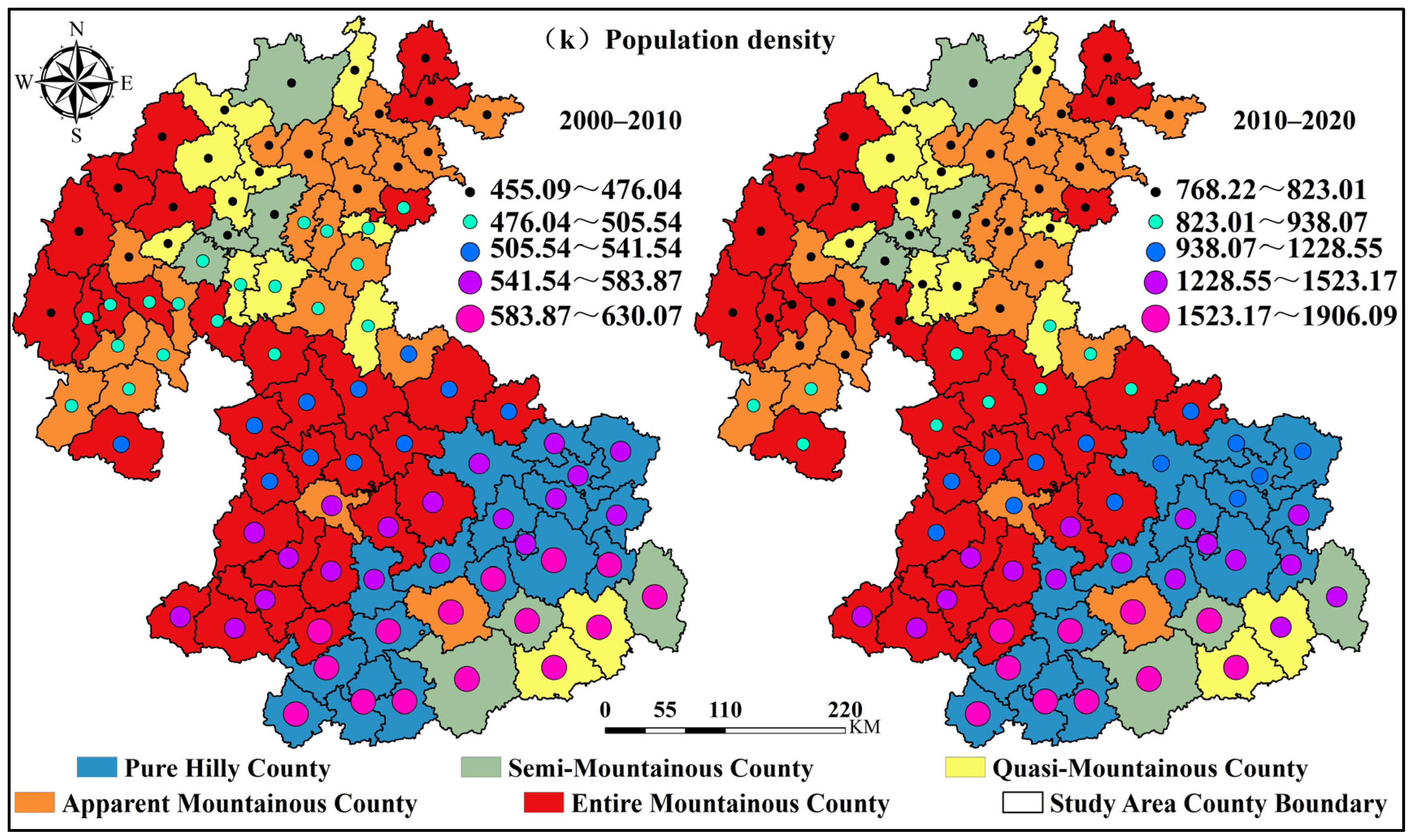It can be seen that the range of regression coefficients for each indicator increased, demonstrating that the spatial and temporal differentiation of the influence of each indicator on CNAC in different periods intensified. For instance, the range of regression coefficients of rocky desertification areas shifted from 27.31–79.58 during 2000–2010 to −148.21 to −256.44 during 2010–2020, with the difference increasing from 52.27 to 108.23, which indicates the significant intensification of negative effects. At the same time, except for agricultural output and population density, which always maintained a positive correlation with CNAC, the influence of other indicators on CNAC changed from a positive to a negative correlation or from a negative to a positive correlation. Overall, population density, agricultural output, effective irrigated areas, and farmer net income per capita exerted a greater influence on CNAC in the Qian-Gui karst mountainous area, while the cropland area per capita exerted the least influence. In addition, throughout the study period, the influence of rocky desertification areas and agricultural machinery power on CNAC was weakened compared to the other indicators, whereas the influence of effective irrigated areas was enhanced.
(2) From the perspective of the different types of counties, the main indicators influencing the CNAC from 2000 to 2020 were population density, agricultural output, effective irrigated area, farmer net income per capita, and grain output per capita. The differences were as follows: ① The contribution of farmer net income per capita and the primary industry employment rate in pure hilly counties was lower than that of the other indicators, while the contribution of grain output per capita and the urbanization rate increased. ② The contribution of agricultural machinery power and the primary industry employment rate decreased in semi-mountainous counties relative to the other indicators, while the contribution of effective irrigated areas increased from 10th to 3rd place. ③ The contribution of GDP per capita in the quasi-mountainous counties decreased relative to the other indicators, from 6th to 10th place, while the contribution of effective irrigated areas increased from 10th to 3rd place. ④ In apparent mountainous counties, the contribution of farmer net income per capita and GDP per capita decreased relative to the other indicators, both falling by three places, while the contribution of effective irrigated areas increased more significantly, from 10th to 3rd place. ⑤ In entirely mountainous counties, the contribution of farmer net income per capita and grain output per capita decreased relative to the other indicators, falling by two places, and GDP per capita decreased by three places. Meanwhile, the contribution of effective irrigated areas increased from 9th to 3rd place, and the share of primary industry employment rate increased from 11th to 8th place.
In summary, excluding the pure hilly county category, effective irrigation coverage (X3) demonstrated significantly enhanced contributions to CNAC across the other county types, emerging as a critical determinant of CNAC. The main reason for this is that the government strengthened the construction of water conservancy facilities. These measures not only enhanced soil productivity but also elevated land use efficiency while ensuring grain production capacity. With continuous improvements in the fundamental water conservancy infrastructure, the study area witnessed a 5522.49 km2 expansion in effective irrigation coverage between 2000 and 2020. Concurrently, through implementing the “Linkage Between Urban-Rural Construction Land Increase and Decrease” policy, local governments have incorporated more marginal cultivated lands into territorial spatial planning adjustments, facilitating the non-agricultural utilization of peri-urban cultivated lands and thereby accelerating CNAC. Representative cases include Guizhou’s Qianzhong Water Conservancy Hub Project, irrigating 434.27 km2 across semi-mountainous, quasi-mountainous, and apparent mountainous counties, and Guangxi’s Baise Reservoir, covering 394.67 km2 across entirely mountainous counties such as Youjiang District, Tianyang District, and Tiandong County.
5.2.1. Spatial and Temporal Variation in Natural Factors
(1) The effect of rocky desertification areas on CNAC changed from a positive to a negative driver (
Figure 6a). Spatially, from 2000 to 2010, the areas with high regression coefficients were concentrated in pure hilly, semi-mountainous, and apparent mountainous counties in southern Guangxi, as well as entirely mountainous counties in western Guizhou. In these areas, the rocky desertification areas showed a positive correlation with CNAC. The highest regression coefficient, 79.58, was recorded in Hengzhou City, a semi-mountainous county. The regression coefficients were all negative in 2010–2020. High values appeared in semi-mountainous, entirely mountainous, and pure hilly counties located in the north of the study area, as well as in its southern regions. This suggests that the reduction in rocky desertification areas in these localities increases the area of CNAC. The maximum value of the regression coefficient was found in Sinan County, −256.44, which is an entirely mountainous county. The driving effect of rocky desertification areas on the CNAC significantly increased compared to the 2000–2010 period.
(2) Between 2000 and 2010, cropland area per capita negatively influenced CNAC in the study area. However, from 2010 to 2020, it had a positive impact on this process in 48 counties (
Figure 6b). Among the 48 counties, 6.25% were pure hilly counties, 4.17% were semi-mountainous counties, 10.42% were quasi-mountainous counties, 22.92% were apparent mountainous counties, and 56.25% were entirely mountainous counties. It can be seen that there was also a gradient in resource and economic development in mountainous areas, and the better the geographical environment, the greater the impact of cropland area per capita on CNAC. Spatially, the areas with a high negative absolute regression coefficient of cropland area per capita in 2000–2010 were distributed in entirely mountainous, quasi-mountainous, and apparent mountainous counties in Guizhou, with the maximum value being −56.27 in Sinan County, which is an entirely mountainous county. The regression coefficient of the cropland area per capita in 2010–2020 was negative in high-value areas, contiguously distributed in semi-mountainous, pure hilly, and quasi-mountainous counties in southeastern Guangxi, and the maximum value was −196.92 in Guiping City, a semi-mountainous county.
5.2.2. Spatial and Temporal Differences in Economic Factors
(1) The impact of agricultural output on CNAC in the examined region remained consistently positive, with the driving effect intensifying (
Figure 6c). Spatially, in 2010–2020, high regression coefficients of agricultural output were observed in the entirely mountainous and apparent mountainous counties, which were along the western and southwestern edges of the study area. For example, Xingyi City and Youjiang District had regression coefficients of 555.43 and 555.57, respectively, indicating a strong positive driving effect. The areas with high regression coefficients in 2010–2020 were concentrated in the entirely mountainous, quasi-mountainous, semi-mountainous, and apparent mountainous counties of the northern Qian-Gui karst mountainous region. These areas include contiguous regions such as Liupanshui City District, Guiyang City District, and the area north of Huangping County. The highest value was found for Zunyi City District, a semi-mountainous county, with a regression coefficient of 1172.05, indicating that the influence of agricultural output on CNAC was very significant.
(2) The impact of farmer net income per capita on CNAC in the study area was almost entirely negative (
Figure 6d), and the negative driving effect increased. The spatial distribution of intensified negative effects was primarily concentrated in the northeastern part of the study area. This included entirely mountainous, quasi-mountainous, semi-mountainous, and apparent mountainous counties in the outer ring region encompassing Dafang County, Guiyang City District, and Majiang County and the southeastern part of the study area, which included pure hilly counties, as well as Wuxuan County in the quasi-mountainous county and the area around Guigang City district. The maximum regression coefficients were found for Fusui County (−195.68) in a pure hilly county and Guiping City (−542.15) in a semi-mountainous county for 2000–2010 and 2010–2020, respectively, indicating a trend of the negative driving effect shifting eastwards.
(3) From 2000 to 2010, the GDP per capita had a positive impact on CNAC in the study area but was negatively driven in 22 counties from 2010 to 2020 (
Figure 6e). Spatially, the high positive GDP per capita regression coefficients from 2000 to 2010 were mostly distributed in pure hilly, semi-mountainous, and entirely mountainous counties in Guangxi, with the maximum value being 124.23 in Guiping City, a semi-mountainous county. Between 2010 and 2020, high positive regression coefficients for the GDP per capita were primarily concentrated in the pure hilly and entirely mountainous counties in Guizhou, as well as the quasi-mountainous and semi-mountainous counties in eastern Guangxi, with a maximum value of 295.41 in Guiping City, a semi-mountainous county in Guangxi. The high-value areas with negative absolute regression coefficients were concentrated in the entirely mountainous and pure hilly counties in the central–southwest of Guangxi, with a maximum value of −120.22 in Longzhou County, which is a pure hilly county. It can be seen that the GDP per capita increased the positive driving force of CNAC in the study area, but its negative influence also increased, showing a trend of polarization.
5.2.3. Spatial and Temporal Variations in Social Factors
(1) The impact of grain output per capita on CNAC in the study area changed from entirely positive to negative (
Figure 6f), especially in pure hilly counties, where the negative driving effect increased. Spatially, the high values of the regression coefficients of grain output per capita during the two periods were concentrated in the pure hilly, semi-mountainous, and quasi-mountainous counties within the central–southern sector of the research area. In stages, between 2010 and 2020, Guiping City—a quasi-mountainous county—exhibited the highest regression coefficient for grain output per capita, which was 140.11. The subsequent decade (2010–2020) saw Guigang City District have the most significant negative regression coefficient of −516.36. At the same time, regions where grain output per capita had a strong positive driving effect on CNAC in 2000–2010 also experienced a significant negative driving effect in 2010-2020. For example, in Tiandeng County, an entirely mountainous county, the regression coefficient changed from 132.02 to −313.46, representing an increase of 2.37 times.
(2) The impact of agricultural machinery power on CNAC was positively driven from 2000 to 2010. However, this trend reversed during 2010–2020, demonstrating negative impacts in 41 counties (
Figure 6g). Spatially, during 2000–2010, areas with high regression coefficients for agricultural machinery power were continuously distributed across the pure hilly, semi-mountainous, and quasi-mountainous counties in the south and southwest of Guangxi. The maximum coefficient of 150.16 was recorded in Hengzhou City, a quasi-mountainous county. During 2010–2020, regions with high positive regression coefficients for agricultural machinery power expanded northwestward compared to the earlier period, with Hengzhou City—a quasi-mountainous county—recording a maximum coefficient of 452.84. In contrast, the largest negative regression coefficients were concentrated in the northwestern, northern, and northeastern parts of Guizhou. In these regions, which included entirely mountainous, semi-mountainous, apparent mountainous, and quasi-mountainous counties, the most negative coefficient of −372.04 was observed in Meitan County, a quasi-mountainous county.
(3) Between 2000 and 2010, the effect of effective irrigated areas was positively correlated with CNAC in 58% of the counties. In contrast, from 2010 to 2020, 60% of the counties exhibited a negative correlation, with the negative effect increasing (
Figure 6h). Spatially, the high positive coefficient areas in 2000–2010 and the high negative coefficient areas in 2010–2020 were continuously distributed in the entirely mountainous, semi-mountainous, quasi-mountainous, and apparent mountainous counties in Guizhou. The maximum values of the regression coefficients for the two periods were 59.15 in Dafang County, an entirely mountainous county, and −575.45 in Meitan County, a quasi-mountainous county. The high negative areas in 2000–2010 and the high positive areas in 2010–2020 were continuously distributed in the pure hilly, semi-mountainous, and quasi-mountainous counties in Guangxi. The maximum values of the regression coefficients for the two periods were −46.05 in Fusui County and 135.30 in Wuxuan County; both are pure hilly counties. This shows that the effective irrigated area in the same location had different driving effects on CNAC in different periods, and the driving effect increased. For example, the effect of effective irrigated areas on CNAC in pure hilly counties changed from negative to positive in 89% of the counties, and the positive effect increased.
(4) From 2000 to 2010, the primary industry employment rate positively influenced CNAC in the study area. However, between 2010 and 2020, this effect became negative in 19 counties, 13 of which were located in pure hilly and semi-mountainous counties (
Figure 6i). Spatially, the high regression coefficients from 2000 to 2010 were continuously distributed in the pure hilly, semi-mountainous, and apparent mountainous counties in Guangxi, with a maximum value of 80.07 in Guiping City, a semi-mountainous county. The high positive values of the regression coefficients from 2010 to 2020 were mostly concentrated in the quasi-mountainous, entirely mountainous, and apparent mountainous counties in the central–northeastern part of the research zone, with a maximum value of 244.34 observed in Cenggong County, an apparent mountainous county. The high-value areas with negative absolute regression coefficients were concentrated in the pure hilly, semi-mountainous, and quasi-mountainous counties in the southwestern part of Guangxi, with a maximum value of −126.09 in Longzhou County, which is a pure hilly county.
(5) Between 2000 and 2010, the urbanization rate negatively drove CNAC in 90% of the counties in the study area. From 2010 to 2020, this effect was positive in half of the counties and negative in the other half (
Figure 6j). Spatially, during the 2000–2010 period, high absolute negative regression coefficients were distributed in the entirely mountainous, quasi-mountainous, and apparent mountainous counties in Guizhou, with a maximum value of −59.41 in Dafang County, an entirely mountainous county. In 2010–2020, the areas with high negative absolute regression coefficients were mostly concentrated in the entirely mountainous, pure hilly, and quasi-mountainous counties in southwest Guangxi, with a maximum value of −269.36 in Guiping City, a semi-mountainous county. The regions with high positive regression coefficient values were predominantly located in Guizhou’s entirely mountainous, semi-mountainous, quasi-mountainous, and apparent mountainous counties, with a maximum value of 51.13 in Panzhou City, an entirely mountainous county. In addition, the negative driving effect of the urbanization rate on CNAC increased in pure hilly counties, which was more than six times higher than in 2000–2010, and the driving effect was much higher than in the other regions.
(6) Population density consistently exerted a positive influence on CNAC (
Figure 6k), with this positive effect showing an increasing trend. This was due to population growth, which increased the demand for impervious surfaces and resulted in the conversion of cropland. The spatial distribution of high regression coefficients during both periods was primarily concentrated in the pure hilly, semi-mountainous, and quasi-mountainous counties of Guangxi, with maximum values of 630.07 in Hengzhou City, a quasi-mountainous county, and 1906.09 in Longzhou County, a pure hilly county, showing a tendency for high-value areas to move westward. This fully reflects the higher population pressure in these areas and the greater challenge of protecting cropland. The low-value areas of the regression coefficients in both periods were concentrated in the entirely mountainous, semi-mountainous, quasi-mountainous, and apparent mountainous counties in Guizhou, with the lowest values of 455.09 in Dafang County, an entirely mountainous county, and 768.22 in Yuqing County, an apparent mountainous county. This was primarily due to the limited availability of flatland cropland resources in these areas, which made large-scale cropland development unsuitable while ensuring food security.














